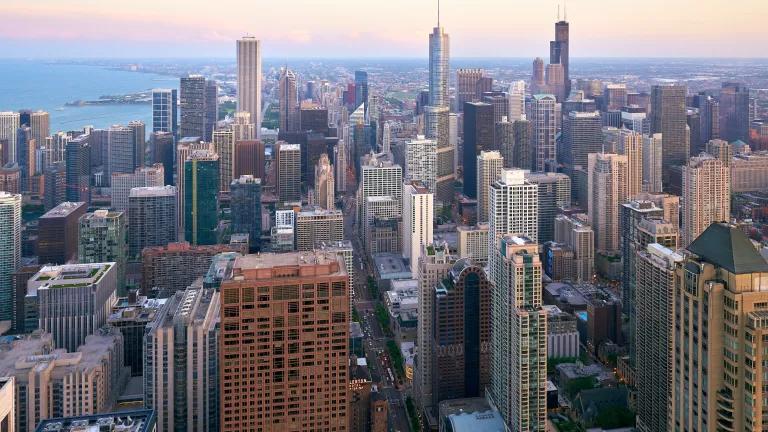NRDC Midwest: Sustainable Workplace Practices in Chicago
NRDC's office achieved LEED Platinum certification, as well as Petal Certification from the Living Building Challenge.

The newest addition to this space—which adheres to the most rigorous sustainable building practices—is Materials Petal Certified under the Living Building Challenge v3.0 and aims for Gold-level certification under the LEED v4 Interior Design and Construction for Commercial Interiors Rating System.

The NRDC Midwest staff moved into their current office, located in Chicago’s historic Civic Opera Building, in June 2013. The space meets rigorous sustainability goals, both achieving a LEED Platinum rating and qualifying as the first commercial office space in the world to gain recognition from the Living Building Challenge.
Through strategic research, design, and implementation, the Midwest office expansion upholds the identity of NRDC’s original Midwest office as a progressive space that defines a new green standard for commercial rehabilitation projects.In 2015, when it was time to expand, the design team of Nushu, LLC and Studio Gang Architects met and exceeded the high bar set by the preceding connected office. Under the guidance of Living Building Challenge consultant, Closed Loop Advisors, and LEED consultant, WMA Sustainability Solutions Group, and with general contracting services by Norcon Inc., the space meets aggressive environmental goals without compromising function or aesthetics. The team’s dedication to the established goals is the reason that NRDC’s Midwest office expansion is Materials Petal Certified under the new 3.0 version of Living Building Challenge. The project also follows LEED v4 for Commercial Interiors guidelines.
Choosing the Location
The Chicago office is within walking distance to the CTA, Metra commuter trains, bus stops, the new Loop Link, and the Divvy bike share program. Secure bike storage is available for employees in a neighboring building’s bike room, and the health club on the 15th floor of the Civic Opera building provides showering and changing facilities.
Accordingly, employees bike to work or take advantage of public transportation more frequently than driving. These commuting decisions reduce local pollution, lessen the Chicago office’s carbon footprint, and improve health and well-being.
Improving Tenant Health through Natural Light and Reduced Toxicity

With windows facing in all four cardinal directions, openness and warmth are inherent characteristics of the office space. A narrow floorplate allows natural light to penetrate deeply into the office and reduces the need for energy use. All windows are easily accessible and operable, enabling occupants to monitor fresh air levels and control their climate naturally. The open floor plan allows for equitable access to daylight and fresh air by occupants both at the peripheries and towards the center of the floor.
All materials, from drywall to minor applications of glue, were vetted for hazardous Red List chemicals. Omitting materials containing these chemicals ensures that laborers during manufacturing, construction workers during renovation, and tenants during regular operations, have limited exposure to toxins. In order to prevent the accumulation of contaminants caused by construction activities, the general contractor implemented measures such as pathway interruption, and heating, ventilation and air conditioning protection. Climbing gardens, hung from wall mounted rope fixtures and columns, were also installed in the expansion space, helping to naturally purify the air while contributing to the aesthetic appeal. The plant species used (Philodendron cordatum & Philodendron brasil) are known to assist in cleaning air by removing large amounts of air toxins and VOCs.
Conserving Energy and Water
While the project did not target the LBC Energy Petal due to building restrictions, all possible measures were taken to bring energy consumption as close to zero as possible and reduce carbon emissions. 90 percent or more of electronics in the office are Energy Star compliant, which means they exceed the government energy efficiency standards and minimize energy usage. All lighting systems use energy efficient bulbs that automatically adjust to the surrounding light conditions, resulting in a lighting power density that is 50 percent lower than the efficiency standard established by building codes. Lights in the work areas turn on automatically dimmed at 50 percent and can be adjusted to users’ comforts. In addition, smart plug sensors automatically power down computers, printers, docking stations, and other electronics at a designated time, saving up to 10 percent of energy usage.
To reduce water usage, low-flow faucets and high efficiency dishwashers were installed. Additionally, NRDC successfully advocated for the installation of low-flow faucets, toilets, and urinals in common floor bathrooms, even though the restrooms are not included in NRDC’s premises according to the lease.
NRDC recognizes that despite the operational measures taken to reduce environmental impact, there are emissions associated with facility construction. To offset the embodied carbon of construction, NRDC purchased a VCS Certified carbon credit that offsets the emissions associated with constructing both the original office and expansion renovations.
Monitoring and Making Use of Data

All NRDC offices use a smart technology energy system to monitor consumption of water and energy, broken down by type, in real time. This information is collected and stored in an online database that provides in-depth reports of energy and water use over periods of time. By increasing the transparency of energy use decisions, the office is better equipped to correct potential inefficiencies, thereby realizing gains beyond those associated with efficiency measures alone.
Maximizing Recycled and Sustainable Materials
Emphasis was placed on recycling materials and reducing waste throughout design and construction phases. The team first evaluated where used or salvaged materials could be inserted, including figuring out how to use materials from the original space that would be affected by expansion construction. When new was the only option, products with recycled content or those salvageable from other locations were given preference. Ceiling panels and work surfaces from the existing office were reconfigured in the expansion. For the pantry, a piece of leftover Cambrian Granite from another project was installed as a countertop. Our efforts effectively reduced contributing to the landfill, conserved resources and resulted in materials cost savings.
One of the multiple steps of vetting materials included a focus on local procurement to decrease the carbon footprint associated with shipping. For example, the ceiling tiles were not only made from Forest Stewardship Council (FSC) certified wood fibers bound together by a non-toxic binding agent; they were also Midwest sourced and manufactured. Due to these efforts, over 50 percent of the construction budget came from within 600 miles of the project site. The team also made a major effort to minimize waste output throughout the construction phase. All construction waste was sorted and recyclables were separated out. The general contractor was able to divert metal and paper waste, resulting in a remarkable 98.4 percent of total project construction waste, from landfills.
To learn more about elements of the office mentioned above, explore the links below:



